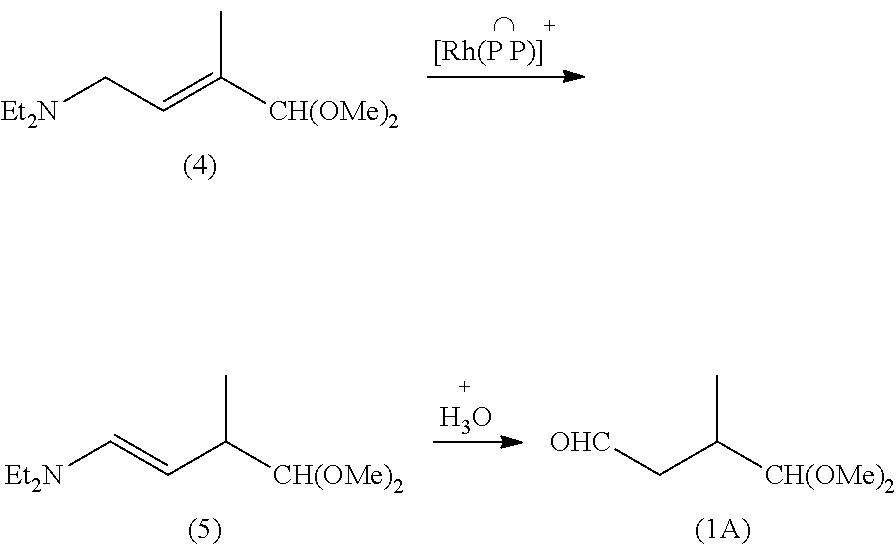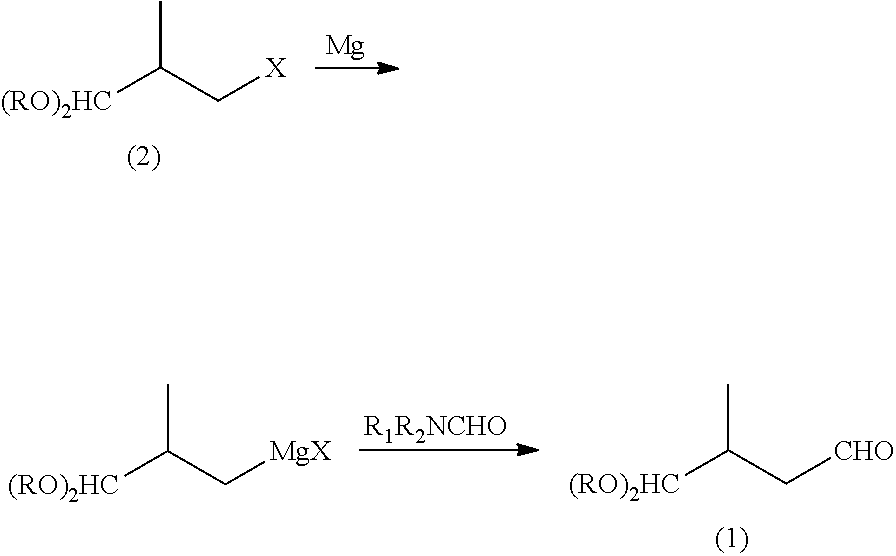Preparation method of lycopene intermediate 3-methyl-4,4-dialkoxy-1-butaldehyde
a technology of lycopene and intermediate, applied in the field of preparation of lycopene intermediate, can solve the problems of difficult and dangerous synthesis, difficult and dangerous acquisition and synthesizing, and use of expensive and complicated catalysts, and achieve the effect of easy availability of raw materials
- Summary
- Abstract
- Description
- Claims
- Application Information
AI Technical Summary
Benefits of technology
Problems solved by technology
Method used
Image
Examples
example 1
Preparation of 3-methyl-4,4-dimethoxy-1-butyraldehyde
[0018]14.4 g (0.6 mol) magnesium powder, 300 ml anhydrous tetrahydrofuran and 10 mg iodine are added in 1 L four necked bottle under stirring and refluxing with protection of nitrogen, 2 ml of a solution containing 98 g (0.5 mol) 2-methyl-3,3-dimethoxy-1-bromopropane and 100 ml anhydrous tetrahydrofuran is added, and then mildly heated to initiate it and the reaction is initiated when the color of iodine disappears. Then the residual 2-methyl-3,3-dimethoxy-1-bromopropane is dropped at temperature of 45° C. for 1 hr, and reacted at 55° C. for 5 hr after finishing the dropping. Then the mixture is cooled to 30° C., and a solution of 67.8 g (0.6 mol) of N-formylpiperidine and 100 ml of anhydrous tetrahydrofuran is dropped for 0.5 hr, and continuously stirred for 0.5 hr after finishing the dropping. Then 100 ml of 10% ammonium chloride aqueous solution is added under stirring for 0.5 hr to separate a water layer. The organic layer is ...
example 2
Preparation of 3-methyl-4,4-diethoxy-1-butyraldehyde
[0023]16.8 g (0.7 mol) magnesium powder, 300 ml anhydrous tetrahydrofuran and 10 mg iodine are added in 1 L four necked bottle under stirring and refluxing with protection of nitrogen, 2 ml of a solution containing 98 g (0.5 mol) 2-methyl-3,3-diethoxy-1-chloropropane and 100 ml anhydrous tetrahydrofuran is added, and then mildly heated to initiate it and the reaction is initiated when the color of iodine disappears. Then the residual 2-methyl-3,3-3,3-diethoxy-1-chloropropane is dropped at temperature of 65° C. for 1 hr, and reacted at 65° C. for 8 hr after finishing the dropping. Then the mixture is cooled to 30° C., and a solution of 40.2 g (0.55 mol) DMF and 50 ml of anhydrous tetrahydrofuran is dropped for 0.5 hr, and continuously stirred for 0.5 hr after finishing the dropping. Then 100 ml of 10% ammonium chloride aqueous solution is added under stirring for 0.5 hr to separate a water layer. The organic layer is extracted with ...
examples 3-8
Preparation of 3-methyl-4,4-dimethoxy-1-butyraldehyde
[0028]Some amount of magnesium powder, 100 ml anhydrous tetrahydrofuran and 10 mg iodine are added in 500 L four necked bottle under stirring and refluxing with protection of nitrogen, 2 ml of a solution containing 0.1 mol 2-methyl-3,3-dimethoxy-1-halopropane and 20 ml anhydrous tetrahydrofuran is added, and then mildly heated to initiate it and the reaction is initiated when the color of iodine disappears. Then the residual 2-methyl-3,3-dimethoxy-1-halopropane is dropped at some temperature for 0.5 hr, and reacted at the temperature for 5 hr after finishing the dropping. Then the mixture is cooled to 30° C., and a solution of some amount of N,N-disubstituted carboxamide and 20 mL of anhydrous tetrahydrofuran is dropped for 0.5 hr, and continuously stirred for 0.5 hr after finishing the dropping. Then 30 mL of 10% ammonium chloride aqueous solution is added under stirring for 0.5 hr to separate a water layer. The organic layer is ...
PUM
| Property | Measurement | Unit |
|---|---|---|
| temperature | aaaaa | aaaaa |
| temperature | aaaaa | aaaaa |
| temperature | aaaaa | aaaaa |
Abstract
Description
Claims
Application Information
 Login to View More
Login to View More - R&D
- Intellectual Property
- Life Sciences
- Materials
- Tech Scout
- Unparalleled Data Quality
- Higher Quality Content
- 60% Fewer Hallucinations
Browse by: Latest US Patents, China's latest patents, Technical Efficacy Thesaurus, Application Domain, Technology Topic, Popular Technical Reports.
© 2025 PatSnap. All rights reserved.Legal|Privacy policy|Modern Slavery Act Transparency Statement|Sitemap|About US| Contact US: help@patsnap.com



